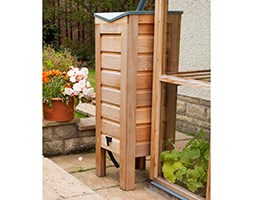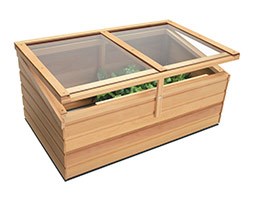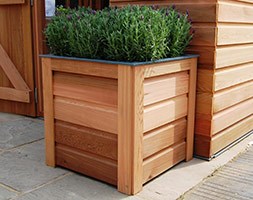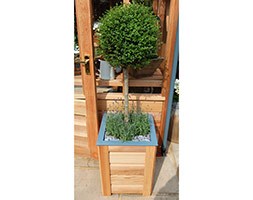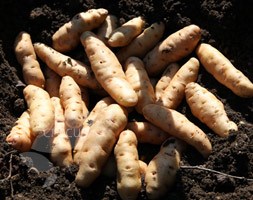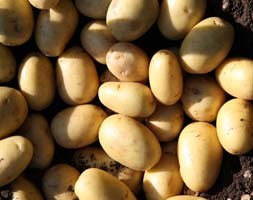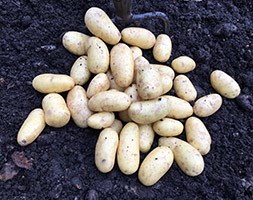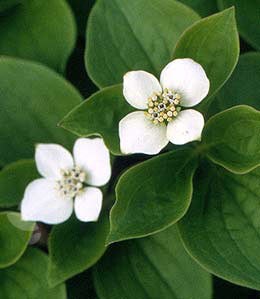New products at Crocus
by Sarah - April 9th, 2016.Filed under: Crocus, New Products.
Crocus just added these new products
Cedar water butt £399.99
Robust and stable Stylish contemporary design Naturally weather-resistant Save rainwater for easy watering of greenhouse and garden plants with this contemporary wooden water butt. Crafted from robust Western Red Cedar, the chunky frame houses a generous 25 gallon water butt, while its slimline design makes it ideal for smaller spaces. Renowned for its stability and longevity, Western Red Cedar contains naturally occurring preservatives that mean you won’t need to weather treat it before use. Over time, the wood will mellow to a cool silver grey, but it can be painted or treated to preserve the warmer tone. The water butt is designed for use with Gabriel Ash cedar greenhouses, and is supplied with all the necessary attachments. It can be connected to other greenhouses, but extra fitments may be required. Approximate measurements: W460mm x L460mm x H1270mm Customers should be aware that this is a self-assembly item and will be delivered in kit form. Instructions for assembly will be enclosed with the product. Please note that we cannot deliver to the following postcodes: KY, FK, PA, DD, PH, AB, IV, HS, KW, or anywhere in the Isle of Wight or the Isle of Man.
Cedar baby coldframe £369.99
Sustainably sourced cedar wood Durable and weather-resistant Strong and stable Keep seedlings snug and overwinter tender plants in this Baby Grand cold frame. Perfect for smaller gardens, the frame does the job of a greenhouse in a fraction of the space. Great for propagating seeds when closed, it can also be held open at different heights to gradually acclimatise young plants to outdoor conditions. Built from sustainable Western Red Cedar, known for its longevity, the frame will protect your vulnerable plants for years to come. The timber’s straight grain means it won’t easily warp or bend, and its natural preservatives make it inherently weather resistant. Over time, the colour will mellow to a silver grey , but it can be treated to preserve the warmer shade if you prefer. Glazed with tempered safety glass, the lid is protected by powder-coated aluminium cappings for improved weather protection. Tough neoprene gaskets keep the glass securely in place. All fixtures are made from a corrosion-resistant combination of brass and stainless steel, and a powder-coated aluminium plinth raises the frame off the ground to protect it from rising moisture. Coordinates with the Gabriel Ash Essentials range of cedar greenhouses. Measurements: W737mm x L1134mm x H506mm Customers should be aware that this is a self-assembly item and will be delivered in kit form. Instructions for assembly will be enclosed with the product. Please note that we cannot deliver to the following postcodes: KY, FK, PA, DD, PH, AB, IV, HS, KW, or anywhere in the Isle of Wight or the Isle of Man.
Cedar planter 600mm £349.99
Naturally weather-resistant Robust and warp-proof Sustainably sourced cedar This chunky square planter adds instant elegance to any outdoor space. Crafte d from high-quality Western Red Cedar, well-known for its longevity and stabilit y, the planter’s stainless steel fixings and powder-coated aluminium top ensure ultimate protection against the elements. Naturally occurring preservatives in the wood mean you won’t need to weather treat it before use. Over time, the wood will mellow to a cool silver grey, but it can be painted or treated to preserve the warmer tone. Coordinates with the Gabriel Ash Essentials range of cedar greenhouses. Measurements: W600mm x L600mm x H600mm Customers should be aware that this is a self-assembly item and will be delivered in kit form. Instructions for assembly will be enclosed with the product. Please note that we cannot deliver to the following postcodes: KY, FK, PA, DD, PH, AB, IV, HS, KW, or anywhere in the Isle of Wight or the Isle of Man.
Cedar planter 450mm £299.99
Naturally weather-resistant Robust and warp-proof Sustainably sourced cedar This chunky square planter adds instant elegance to any outdoor space. Crafte d from high-quality Western Red Cedar, well-known for its longevity and stabilit y, the planter’s stainless steel fixings and powder-coated aluminium top ensure ultimate protection against the elements. Naturally occurring preservatives in the wood mean you won’t need to weather treat it before use. Over time, the wood will mellow to a cool silver grey, but it can be painted or treated to preserve the warmer tone. Coordinates with the Gabriel Ash Essentials range of cedar greenhouses. Measurements: W450mm x L450mm x H600mm Customers should be aware that this is a self-assembly item and will be delivered in kit form. Instructions for assembly will be enclosed with the product. Please note that we cannot deliver to the following postcodes: KY, FK, PA, DD, PH, AB, IV, HS, KW, or anywhere in the Isle of Wight or the Isle of Man.
potato ‘Anya’ (second early seed potato) £9.99
We sell potatoes by weight but you can expect to receive about 20 tubers of this variety in a 2kg bag. Position: sun-partial shade Soil: fertile, well drained Rate of growth: fast-growing Harvesting period: July Hardiness: protect tubers from frost A cross between a Pink Fir Apple and a Desiree potato, Anya is a very popular salad variety that tastes equally good served hot or cold. They have a knobbly, elongated-oval shape and their skin has a pink flush. The reasonably waxy flesh has a nutty flavour, which lends itself well to a host of tasty recipes. These seed potatoes are produced by Albert Bartlett Garden care: As soon as the potato tubers have been delivered you should unpack them and start the chitting (sprouting) process. Place them in single layer in a seed tray without compost and leave in a light, cool area protected from frost. This can be started about six weeks before you intend to plant them. Early varieties can be planted out under frost fleece protection, but the later varieties should be planted after the worst frosts have passed in your area – this is generally mid March to mid April. Dig a trench 8 – 13cm (3 – 5in) deep adding a general purpose fertiliser to the bottom of the trench. Plant the potato tubers in the trenches about 30cm (12in) apart, being careful not to knock the shoots off the tubers, and keeping the shoots facing upwards. Then lightly cover with soil. As the plants get to around 20cm (8in) tall you need to bank up the soil around the plant, so the soil covers the bottom two thirds of the plant. Watering your plants well will help improve crop yield and discourage potato scab.
potato ‘Vivaldi’ (second early seed potato) £9.99
We sell potatoes by weight but you can expect to receive about 20 tubers of this variety in a 2kg bag. Position: sun-partial shade Soil: fertile, well drained Rate of growth: fast-growing Harvesting period: July Hardiness: protect tubers from frost Voted ‘most elegant spud of the year’, by our Kitchen Garden blogger Sally Nex, ‘Vivaldi’ has recently been developed by a Lincolnshire company called Naturally Best. It is said to have 26% less carbohydrate and a third fewer calories than many other varieties. There has been no compromising on the flavour though as the flesh of the yellow-skinned, oval tubers is deliciously creamy. It is a great all-rounder, which shows some resistance to scab. These seed potatoes are produced by Albert Bartlet. Garden care: As soon as the potato tubers have been delivered you should unpack them and start the chitting (sprouting) process. Place them in single layer in a seed tray without compost and leave in a light, cool area protected from frost. This can be started about six weeks before you intend to plant them. Early varieties can be planted out under frost fleece protection, but the later varieties should be planted after the worst frosts have passed in your area – this is generally mid March to mid April. Dig a trench 8 – 13cm (3 – 5in) deep adding a general purpose fertiliser to the bottom of the trench. Plant the potato tubers in the trenches about 30cm (12in) apart, being careful not to knock the shoots off the tubers, and keeping the shoots facing upwards. Then lightly cover with soil. As the plants get to around 20cm (8in) tall you need to bank up the soil around the plant, so the soil covers the bottom two thirds of the plant. Watering your plants well will help improve crop yield and discourage potato scab.
potato ‘Jazzy’ (potato – second early, Scottish basic seed potato) £9.99
These are sold in 2kg packs, so the pack will contain approximately 20 tubers. Position: sun-partial shade Soil: fertile, well drained Rate of growth: fast-growing Harvesting period: May – June Hardiness: protect tubers from frost Jazzy is a new small potato That has has a waxy set skinned variety it hasalready won the prestigous Royal Horticultral Society Award of Garden Merit. Taste wise its bursting with flavour and very versatile. It is suitable for boiling steaming and mash as well as roasting with exceptional flavour Garden care: As soon as the potato tubers have been delivered you should unpack them and start the chitting (sprouting) process. Place them in single layer in a seed tray without compost and leave in a light, cool area protected from frost. This can be started about six weeks before you intend to plant them. Early varieties can be planted out under frost fleece protection, but the later varieties should be planted after the worst frosts have passed in your area – this is generally mid March to mid April. Dig a trench 8 – 13cm (3 – 5in) deep adding a general purpose fertiliser to the bottom of the trench. Plant the potato tubers in the trenches about 30cm (12in) apart, being careful not to knock the shoots off the tubers, and keeping the shoots facing upwards. Then lightly cover with soil. As the plants get to around 20cm (8in) tall you need to bank up the soil around the plant, so the soil covers the bottom two thirds of the plant. Watering your plants well will help improve crop yield and discourage potato scab.
Cornus canadensis (creeping dogwood) £9.99
Position: full sun to partial shade Soil: fertile, humus-rich, well-drained, neutral to acid soil Rate of growth: average Flowering period: May and June Hardiness: fully hardy Showy white petal-like flower bracts look really pretty when they appear in late spring and early summer, framed by a collar of rich green leaves. After they fade, they are followed in autumn by a jaunty cluster of bright red berries. This creeping dogwood is an attractive groundcover for the front of a shrub border or woodland garden. It performs best in a partially shaded spot in fertile, humus-rich, well-drained, neutral to acid soil. Garden care: Incorporate a quantity of composted pine needles or well-rotted leaf mould when planting. Divide large colonies of plants in spring or autumn.
potato ‘Pink Fir Apple’ (potato – maincrop, Scottish basic seed potato) £8.99
We sell potatoes by weight but you can expect to receive about 24 tubers of this variety in a 2kg bag. Position: sun-partial shade Soil: fertile, well drained Rate of growth: fast-growing Harvesting period: October Hardiness: protect tubers from frost A Heritage salad potato bred in 1850. This late maincrop potato has knobbly pink skinned tubers of butter yellow, waxy flesh. An unusual potato that’s great as a salad potato but can also be used to make delicious chips – with a single tuber for each chip! It has been given an Award of Garden Merit (AGM) by the Royal Horticultural Society. Garden care: As soon as the potato tubers have bee n delivered you should unpack them and start the chitting (sprouting) process. Place them in single layer in a seed tray without compost and leave in a light, cool area protected from frost. This can be started about six weeks before you intend to plant them. Early varieties can be planted out under frost fleece protection, but the later varieties should be planted after the worst frosts have passed in your area – this is generally mid March to mid April. Dig a trench 8 – 13cm (3 – 5in) deep adding a general purpose fertiliser to the bottom of the trench. Plant the potato tubers in the trenches about 30cm (12in) apart, being careful not to knock the shoots off the tubers, and keeping the shoots facing upwards. Then lightly cover with soil. As the plants get to around 20cm (8in) tall you need to bank up the soil around the plant, so the soil covers the bottom two thirds of the plant. Watering your plants well will help improve crop yield and discourage potato scab.







